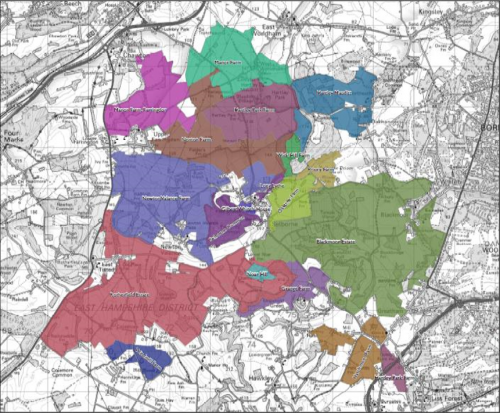Ref: CSFF130001
Lead: Debbie Miller, debbie.ar.miller@gmail.com
Group members: 17
Length of agreement: 5
Area of group (Hectares): 4182
Selborne’s varied landscape is underpinned by 5 soil types each supporting different wildlife. This variety was first acknowledged by Gilbert White.
Group Themes:
Woodlands and Grassland: protect, enhance and link existing species rich sites with wider countryside
Farm Wildlife: co-ordinated habitat creation for pollinators, farmland birds, mammals
Soils & Water: best practice soil management to enhance water quality; bankside management; enhance & connect pond network
Heritage & Culture: increase awareness of historic environment; develop links with local community
Priorities:
1. Biodiversity; 1.1 Designated Sites · Hangers (Natura 2000 site, SAC, SSSI) · Noar Hill (National Nature Reserve, SSSI) · Selborne Common (SSSI)
1.2 Priority Habitats · Ancient Woodland · Wood Pasture & Parkland · Lowland calcareous grassland & Lowland meadows · Fen, floodplain grazing marsh & rush pasture · Riparian · Arable field margins · Lowland heath
1.3 Priority Species CS priority species present: duke of burgundy, brown hairstreak, corn bunting, lapwing, turtle dove. S41 species e.g. harvest mouse, dormouse, great crested newt.
1.4. Woodland bird assemblage Willow tit, spotted flycatcher, tree pipit, lesser spotted woodpecker present.
1.5 Wild pollinator & farm wildlife package Farm Wildlife Package Hotspot for pollinators. S41 species e.g. grey partridge; CS priority species.
2. Woodland: Natura 2000 sites, SSSI & SAC; ASNW, PAWS, priority species; new planting.
3. Landscape: hedgerows, trees, permanent grassland – all present
4.Water Quality: Phosphate, nitrate, sediment & pesticides in Rother and Wey. Two EA surface water safeguard zones highlights methaldehyde, carbetamide & glyphosate as ‘at risk’ substances
5.Historic Environment: · Scheduled Ancient Monuments (SAMs) e.g. Selborne Priory · Non-statutory sites e.g. sunken lanes · Registered Parks & Gardens II* e.g. The Wakes · Listed farm buildings
6.Multiple benefits & synergies: landscape character, connectivity & water quality; habitat management for priority species & pollinators, climate change adaptation.

